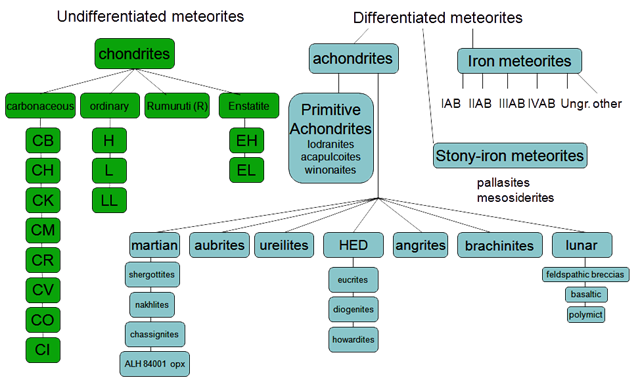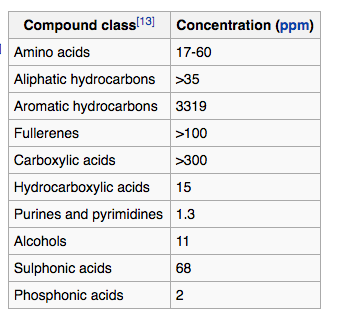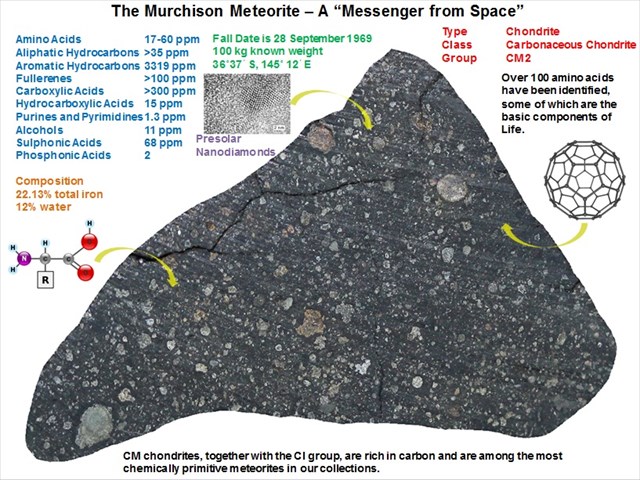Geo son was keen to put this EC together so we have also made it a low D/T hoping to encourage more cachers to attempt EC’s and learn about this fascinating ‘alien rock’.
We have taken the following information from Wikipedia as we felt it was the best explanations available for this platform, a lot of the other sources were very complex.
The Murchison meteorite is a large meteorite that fell to earth near Murchison, Victoria, in Australia, in 1969. It is one of the most studied meteorites due to its mass (>100 kg), the fact that it was an observed fall, and that it belongs to a group of meteorites rich in organic compounds.
On 28 September 1969 at about 10:58am local time, near the town of Murchison, Victoria, a bright fireball was observed to separate into three fragments before disappearing, leaving a cloud of smoke. About 30 seconds later, a tremor was heard. Many fragments were found over an area larger than 13 km², with individual mass up to 7 kg; one, weighing 680 g, broke through a roof and fell in hay. The total collected mass exceeds 100 kg.
Classification and composition: The meteorite belongs to the CM group of carbonaceous chondrites.

Like most CM chondrites, Murchison is petrologic type 2, which means that it experienced extensive alteration by water-rich fluids on its parent body before falling to Earth. CM chondrites, together with the CI group, are rich in carbon and are among the most chemically primitive meteorites. Like other CM chondrites, Murchison contains abundant CAIs. Over 15 amino acids (some of the basic components of life) have been rapidly identified in the meteorite, and more later. All the amino acids found in the Murchison meteorite have been synthesized in laboratory experiments by the action of electric discharge on a mixture of methane, nitrogen, and water with traces of ammonia.
Organic compounds: The Murchison meteorite contains common amino acids such as glycine, alanine and glutamic acid as well as unusual ones like isovaline and pseudoleucine. A complex mixture of alkanes was isolated as well, similar to that found in the Miller–Urey experiment. Serine and threonine, usually considered to be earthly contaminants, were conspicuously absent in the samples. A specific family of amino acids called diamino acids was identified in the Murchison meteorite as well.
The initial report stated that the amino acids were racemic and therefore formed in an abiotic manner because amino acids of terrestrial proteins are all of the L-configuration. Later the amino acid alanine, which is also a protein amino acid, was found to have an excess of the L-configuration, which led several to suspect terrestrial contamination according to the argument that it would be "unusual for an abiotic stereo selective decomposition or synthesis of amino acids to occur with protein amino acids but not with non-protein amino acids." In 1997, L-excesses were also found in a non-protein amino acid, isovaline, suggesting an extra-terrestrial source for molecular asymmetry in the Solar System. At the same time, L-excesses of alanine were again found in Murchison but now with enrichment in the isotope 15N, however, the isotopic pairing was later contested on analytical grounds. The list of organic materials identified in the meteorite was extended to polyols by 2001.

Although the meteorite contained a mixture of left-handed and right-handed amino acids, most amino acids used by living organisms are left-handed in chirality, and most sugars used are right-handed. A team of chemists in Sweden demonstrated in 2005 that this homochirality could have been triggered or catalyzed, by the action of a left-handed amino acid such as proline.
Several lines of evidence indicate that the interior portions of well-preserved fragments from Murchison are pristine. A 2010 study using high resolution analytical tools including spectroscopy, identified 14,000 molecular compounds including 70 amino acids in a sample of the meteorite. The limited scope of the analysis by mass spectrometry provides for a potential 50,000 or more unique molecular compositions, with the team estimating the possibility of millions of distinct organic compounds in the meteorite.
Nucleobases: Measured purine and pyrimidine compounds were found in the Murchison meteorite. Carbon isotope ratios for uracil and xanthine of δ13C = +44.5‰ and +37.7‰, respectively, indicate a non-terrestrial origin for these compounds. This specimen demonstrates that many organic compounds were delivered by early Solar System bodies and may have played a key role in life's origin.
Presolar grains: are interstellar solid matter in the form of tiny solid grains that originated at a time before the Sun was formed (presolar: before the Sun). Meteoriticists often use the term to represent stardust, grains that originated within a single star and which they extract from meteorites for study. Because most interstellar grains are not stardust from a single star, however, being instead interstellar cloud matter accreted by smaller presolar grains, most presolar grains are also not stardust. Logistically, all stardust are presolar grains; but not all presolar grains are stardust. This confusing terminology is heavily entrenched among 21st century meteoriticists who prefer to use the terms interchangeably, however, so it is best to live with both usages or to write presolar stardust grains for stardust.
Presolar stardust grains formed within outflowing and cooling gases from earlier presolar stars. The stellar nucleosynthesis that took place within each presolar star gives to each granule an isotopic composition unique to that parent star, which differs from the isotopic composition of our solar system's matter as well as from the galactic average. These isotopic signatures often fingerprint very specific astrophysical nuclear processes that took place within the parent star and prove their presolar origin.

To successfully log this cache please use your own judgment and the information provided to answer the following questions and send us your answers to the best of your ability;
1. Was the direction the meteorite travelled?
2. What everyday item is said to be also contained in the meteorites makeup?
3.What is a presolar nano diamond?
4. A photo of your team, GPS near GZ with your log and answers. If you happen to make it to the historical society that would be a fantastic photo for your log too. (optional)
You are welcome to log your answers straight away to keep your TB's and Stats in order but please message us with your answers. Cachers who do not fulfil the Earth Cache requirement will have their logs deleted.

Source: Wikipedia, http://www.markelowitz.com,
